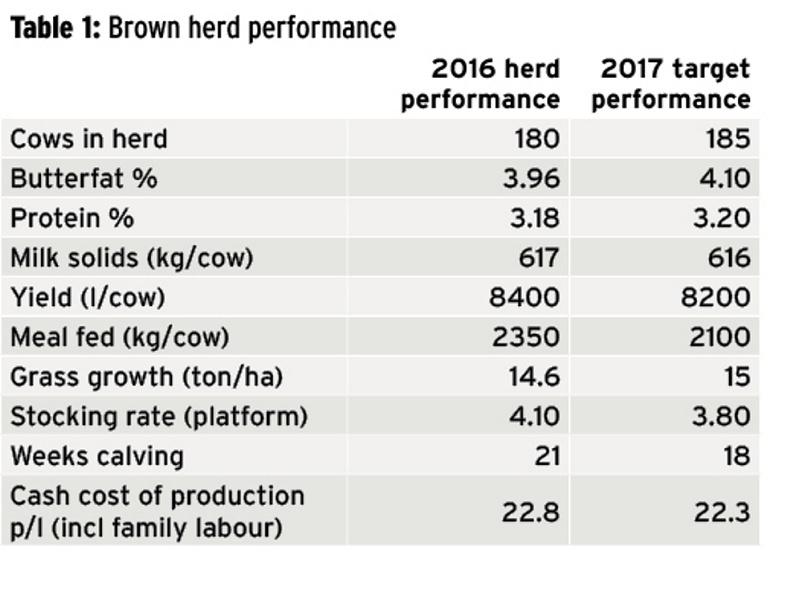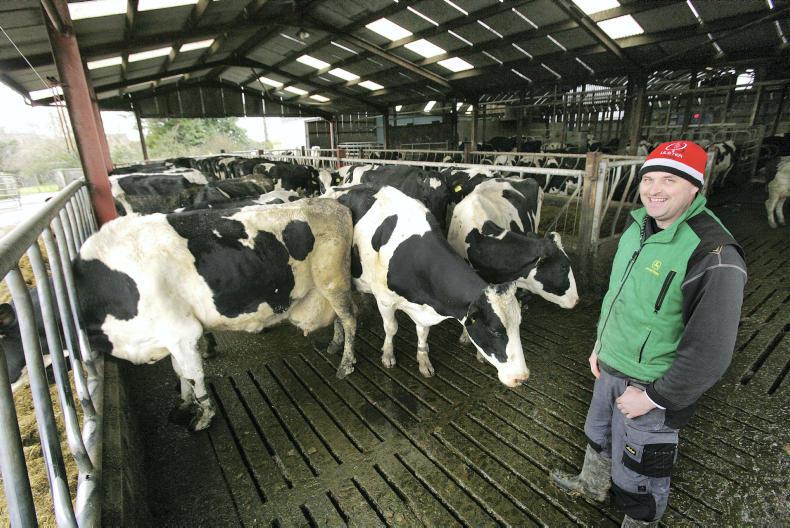Extremely dry conditions are proving to be a challenge for Bill Brown, and a dry forecast will not help the situation on the farm. However, the dry conditions are not holding back profitability.
Budgeted financial figures for the farm suggest a 55% increase in farm net margin over 2016 performance. While a significant chunk of this is from an improved milk price received so far in 2017, increased efficiency and better utilisation of grass on the farm is also playing a major role in the better returns.
Production per cow has fallen on the farm, with milk sales per cow now at 8,200 litres, down some 200 litres per cow. The drop in production has been more than offset with a lower cost base across the farm, resulting in a net margin increase of 9p/l. Seventy percent of this comes from better milk prices the farm is receiving, the remaining 30% comes from improved efficiency – more grass and improving herd fertility is improving profitability.
Improving herd fertility is also affecting profitability. Getting more cows back in calf faster means that effectively cows are spending more time in early lactation. Bill entered the Dairylink programme with an average cost of production on the farm of 26.4p/l, the projected cost for 2017 is 22.3p/l, which includes capital investment in infrastructure and family wages. With half the year now gone, Bill is ahead of his profitability targets.
Bill Brown Millisle, Co Down
Dry conditions on the farm over the past month have hampered regrowth on the grazing block and the 15 acres reseeded at the end of April are looking poor and badly in need of moisture. There has only been one day of rain in the past month here.
The grazing block is changing every week, with more second-cut silage area coming into the rotation. This week we were forced to graze low covers of around 1,100kgDM/ha. Currently, we are at 140kg of grass DM/cow. With slowing growth and the herd grazing six acres per day this will drop fast. Therefore, in an attempt to increase supply and allow the pre-grazing cover move up to around 1,400kgDM/ha, we have been feeding silage (4kg), and will hold the current meal feeding level (5kg).
The stocking rate on the grazing block is changing every week. Dry conditions allow us to graze on silage aftergrass, even though we have no farm roadway into those paddocks.
Last week, stocking rate was 3.8 cows/ha, and I plan to move to 3.4 cows/ha this week. Silage will stay in the system until we can lift the pre-grazing cover to around 1,400kg. Current herd performance is 28 litres at 3.81% fat and 3.44% protein. The herd average days in milk is 180, with somatic cell count at 170 cells/ml.
I use a platemeter to measure grass, which generally works well. However, I find the platemeter does not accurately measure paddocks with high stem content.
I plan to cut and weigh grass for the next few measurements. Nitrogen is going on pre-grazing, so the grass provides some shade, with 30 units of CAN on across the grazing block. Last year 100 tonnes of lime was spread on low-pH paddocks. Based on soil reports for 2017, an additional 80 tonnes are required this year.
A compound fertiliser will be used for the next rotation, with 25-5-5 planned across the grazing block. I will also use 20-10-10 on 28 acres of the grazing block, which analysis highlighted as very deficient in phosphorus (P) and potassium (K).
Pre-mowing some paddocks is ensuring the residual grass is on target. The extremely dry weather is forcing the grass into stem at low covers, which I need to remove. Areas reseeded last year are performing very well. I used Abergain and Aberchoice, with cows currently grazing this area for the fifth time this year. Average growth for 2017 to date on the farm is 4.4tDM/ha, with last year’s reseeded area doing 5.1tDM/ha.
The upside of the excellent weather is it has allowed progress on additional farm lanes and a bridge on the farm. Last year, 80m of a new cow lane gave me access to 20 acres. This year, I have 120m in and a further 110m to go in. The objective is to increase the total area available for grazing by providing infrastructure, which includes lane, fencing and water for the herd.
My target is 3.5 cows/ha, which will give me the flexibility to reduce stocking density in periods like this when growth is low. It will also allow more grazing in the early part of the season and allow me capitalise on the dry land available.







 This is a subscriber-only article
This is a subscriber-only article











SHARING OPTIONS: